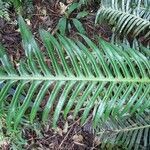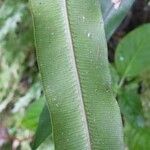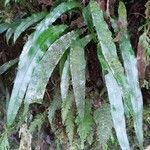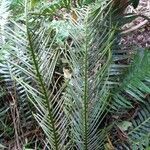Rhizome short-decumbent, up to 12 mm in diam., with stipe bases and ferruginous, lanceolate to subulate scales, up to 22 x 2 mm, margins with glands and hairs. Fronds arching, dimorphic, the fertile generally overtop the sterile; sterile up to 1.24 m long; fertile short-lived. Stipe firm; sterile up to 175 mm long, up to 10 mm in diam.; fertile up to 180 mm long, up to 6 mm in diam., proximally densely set with ferruginous, linear-flagelliform scales, up to 18 x 1.2 mm, margins with glands and hairs. Lamina pinnatisect; sterile elliptic, up to 1.2 m x 340 mm; fertile elliptic, up to 650 x 170 mm. Pinnae sterile herbaceous to subcoriaceous, adnate, linear-attenuate to triangular, entire, with an abruptly widened base, glabrous adaxially and abaxially, up to 195 x 15 mm; fertile herbaceous, adnate, entire or shallowly and irregularly lobed, up to 150 x 2.5 mm, with an abruptly widened base, glabrous adaxially. Sori linear, extending from above base to near apex of fertile pinnae. Indusium linear, erose.
Rhizome creeping, up to 450 mm long, 20-34 mm in diameter, set with dark brown, subulate rhizome-scales up to 42 x 3 mm, sometimes spirally twisted when dry. Fronds arching, thinly coriaceous; stipe light brown to stramineous, sulcate, set with occasional scales near base; sterile lamina elliptic, up to 1.8 x 0.22 m, pinnate (occasionally 2-pinnatifid) lower pinnae gradually decrescent; pinnae narrowly oblong-attenuate, entire (occasionally irregularly pinnatifid or slightly undulate), sessile with an abruptly widened base wholly adnate to rhachis and somewhat contiguous, margin narrowly reflexed, upper surface glabrous, lower surface set with occasional scales along costa; fertile lamina elliptic, pinnate; pinnae linear, sessile with an abruptly widened base adnate to rhachis, often recurved or pendent. Sori extending from above base almost to apex of fertile pinnae; indusium dark brown, erose, c. 1 mm broad.
Terrestrial, epilithic or epiphytic. Rhizome creeping to suberect. Fronds tufted, arching, pinnate with pinna bases adnate to rachis, sterile lamina narrowly elliptic to narrowly oblanceolate, 0.31.8 m x 45-360 mm, basal pinnae reduced, glabrous adaxially, subglabrous abaxially, pinnae oblong-acute to linear attenuate, margins entire; fertile lamina similar in size to sterile lamina, pinnae linear, ± 3 mm wide, bases widened and adnate to rachis. Sporangia in linear sori borne on whole length of pinna, with linear, entire indusium.
Rhizomatous perennial. Fronds arching, to 1 m long, stipe scaled, sterile lamina firmly herbaceous, elliptic, pinnatifid, dark green above, pale below, basal segments decrescent, narrowly oblong-attenuate, entire, fertile lamina elliptic, pinnate, pinnae linear, sessile. Sori extending most of the length of the fertile pinnae, indusium erose.
Rhizome creeping, set with dark brown rhizome scales. Sterile pinnae with bases broadest and wholly adnate to rhachis. Lamina long-decrescent, basal pinnae becoming deltate and then rudimentary at extreme base. Sterile pinna apices attenuate to acute-acuminate. Rhachis usually sunken, deeply sulcate above.





